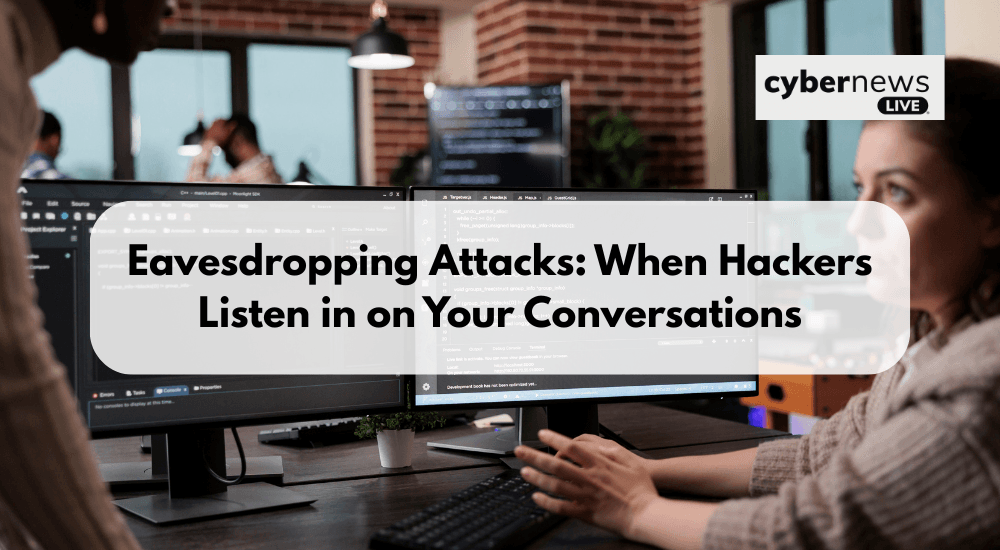
Eavesdropping Attacks: When Hackers Listen in on Your Conversations
Eavesdropping, also known as sniffing or snooping, is a serious cyber security concern for both individuals and organizations. It involves covertly intercepting private communications, allowing malicious actors to gain unauthorized access to sensitive information such as personal correspondence, financial data, proprietary business details, and strategic communications.
This sophisticated attack can be carried out through various means, including physical surveillance, wiretapping, packet sniffing, and Man-in-the-Middle techniques. It can compromise a wide range of communication channels, including voice calls, emails, messaging services, and even encrypted network transmissions. Eavesdropping is especially dangerous because it often occurs silently, without triggering any alerts during data transmission.
Let us explore how eavesdropping attacks operate.
How do Eavesdropping Attacks work?

Eavesdropping attacks exploit weaknesses in communication channels to intercept data during transmission covertly. These attacks can range from simple passive monitoring to sophisticated, active manipulation of data streams. Here’s how a typical eavesdropping attack works.
Network Shifting
One of the most prevalent methods of eavesdropping involves the use of packet sniffers. These tools are designed to monitor and analyze network traffic. Attackers utilize software such as Wireshark or tcpdump to capture data packets traveling across a network. This can expose sensitive information, including login credentials, personal details, and financial data, especially if the data is not encrypted.
Adversary-in-the-Middle (AitM) Attacks
Often referred to as Man-in-the-Middle (MitM) attacks, this technique involves the attacker placing themselves between two communicating parties. By intercepting and relaying communications, the attacker can monitor or modify the content of messages in real time. These attacks are especially dangerous as they enable both passive surveillance and active data manipulation.
Wireless Eavesdropping
Wireless networks, especially public Wi-Fi hotspots, are prime targets for eavesdropping. Attackers may set up rogue access points or exploit vulnerabilities in wireless encryption protocols (e.g., WEP, WPA) to intercept data being transmitted over the network. Unsuspecting users connected to these networks are often unaware of the intrusion.
Physical Interception
In specific scenarios, attackers may gain physical access to communication lines or environments. This could involve installing covert listening devices (bugs), microphones, or tapping directly into wired networks. Such methods are often used in high-stakes espionage or corporate surveillance operations.
VoIP Interception
Voice-over-IP (VoIP) technologies, used for internet-based phone calls, are also susceptible to eavesdropping. Without proper encryption, VoIP traffic can be intercepted and recorded, exposing private conversations and sensitive business information.
How To Prevent Eavesdropping Attacks
Preventing an eavesdropping attack requires a multi-layered approach that combines technical solutions with best practices. Here are some of the most effective ways to protect against eavesdropping attacks:
Implement Strong Encryption
Encryption serves as the cornerstone of data security. Employ end-to-end encryption for all sensitive communications to ensure that only intended recipients can access the content. Utilize protocols such as SSL/TLS for securing web traffic and IPsec or VPNs for encrypted network communication.
Adopt Secure Network Protocols
Use encrypted protocols, such as HTTPS (Hypertext Transfer Protocol Secure), for web services and SSH (Secure Shell) for remote administrative access. These protocols help establish protected channels, even over unsecured networks, reducing the risk of data exposure.
Use Virtual Private Networks (VPNs)
VPNs encrypt internet traffic between a user’s device and a secure server, offering protection against eavesdropping, especially on public or untrusted networks. Organizations should mandate the use of VPNs for all remote work and public Wi-Fi connections to ensure secure access to sensitive information.
Regular Software Updates
Keeping software and systems up to date is essential. Security patches often address vulnerabilities that attackers may exploit for eavesdropping. This includes operating systems, browsers, communication platforms, and antivirus solutions.
Network Segmentation
Divide your network into isolated segments to limit the scope of any potential attack. By restricting access between segments, mainly where sensitive data resides, you can reduce the potential impact of a breach.
Robust Authentication Mechanisms
Implement multi-factor authentication (MFA) to enhance access control and security. Even if credentials are intercepted, MFA adds an extra layer of protection, significantly reducing the chances of unauthorized access.
Avoid Suspicious Links and Downloads
Phishing attempts and malicious downloads can install spyware or other malware that tracks your online activity. Always exercise caution when clicking unfamiliar links or downloading attachments from unknown sources.
Employee Education and Awareness
Human error is often the weakest link in cyber security. Conduct regular training to raise awareness of eavesdropping risks, phishing schemes, and secure communication practices. Empower users to recognize and respond appropriately to suspicious activity.
Physical Security Measures
Secure your physical network infrastructure. Limit access to communication equipment, server rooms, and wiring closets to prevent attackers from installing eavesdropping devices or tapping into communication lines.
Use Secure Communication Platforms
Encourage the use of reputable, encrypted messaging and conferencing platforms that support secure end-to-end communication. Platforms such as Signal, WhatsApp Business, and Microsoft Teams, which offer encryption, provide enhanced protection for sensitive discussions.
Conclusion
Eavesdropping attacks are not merely a technical challenge, but a comprehensive security concern that demands vigilant planning and execution. By integrating encryption, secure protocols, user education, and monitoring mechanisms, organizations and individuals can significantly reduce the risk of unauthorized data interception.
Stay informed. Stay protected. Follow Cyber News Live for real-time updates, expert analysis, and actionable insights on the latest cyber security threats.




